Non-Destructive X-ray Spectrometric and Chromatographic Analysis of Metal Containers and Their Contents, from Ancient Macedonia
Abstract
1. Introduction
2. Materials and Methods
2.1. Energy Dispersive Micro-X-ray Fluorescence spectrometry (EDμXRF)
2.2. X-ray Diffraction (XRD)
2.3. Head Space—Solid Phase Micro-Extraction/Gas Chromatography—Mass Spectrometry (HS—SPME/GC—MS)
2.4. High Pressure Liquid Chromatography—Diode Array Detector (HPLC-DAD)
3. Results
3.1. Metal Containers
3.2. Contents of the Metal Containers
4. Discussion
4.1. Metal Containers
4.2. Contents of the Metal Containers
5. Conclusions
Author Contributions
Funding
Acknowledgments
Conflicts of Interest
References
- Themelis, P.; Touratsoglou, G. The tombs of Derveni; Ministry of Culture–Archaeological Receipts Fund: Athens, Greece, 1977. (In Greek) (Θέμελης, Π., Τουράτσογλου, Γ., 1997. Οι τάφοι του Δερβενίου, Υπουργείο Πολιτισμού—Ταμείο Αρχαιολογικών Πόρων και Απαλλοτριώσεων, Αθήνα) [Google Scholar]
- Tsigarida, B.; Ignatiadou, D. The Gold of Macedon: Archaeological Museum of Thessaloniki, Archaeological Receipts Fund; Archaeological Museum of Thessaloniki: Thessaloniki, Greece, 2000. [Google Scholar]
- Chrysostomou, P. Contributions to the history of medicine in ancient Macedonia. Eulimene 2002, 3, 99–116. (In Greek) (Χρυσοστόμου, Π. 2002, «Συμβολές στην Ιστορία της Ιατρικής στην Αρχαία Μακεδονία», Ευλιμένη 3, 99–116») [Google Scholar]
- Ignatiadou, D. The warrior priest in Derveni grave B was a healer too, Histoire. Méd. Santé 2016, 8, 89–113. [Google Scholar] [CrossRef]
- Guerra, M.F. Analysis of archaeological metals, The place of XRF & PIXE in the determination of technology and provenance. X-ray Spectrom. 1998, 27, 73–80. [Google Scholar]
- Cechak, T.; Hlozek, M.; Musilek, L.; Trojek, T. X-ray fluorescence in investigations of archaeological finds. Nucl. Instrum. Methods Phys. Res. Sect. B 2007, B263, 54–57. [Google Scholar] [CrossRef]
- Karydas, A.G. Application of a portable XRF spectrometer for the non invasive analysis of museum metal artefacts. Ann. Chim. 2007, 97, 419–432. [Google Scholar] [CrossRef] [PubMed]
- Charalambous, A.; Kassianidou, V.; Papasavvas, G. A compositional study of Cypriot bronzes dating to the Early Iron Age using portable X-ray fluorescence spectrometry (pXRF). J. Archaeol. Sci. 2014, 46, 205–216. [Google Scholar] [CrossRef]
- Stuart, B. Analytical Techniques in Materials Conservation; John Wiley & Sons Ltd.: Chichester, UK, 2007; p. 194. [Google Scholar]
- Bronk, H.; Rohrs, S.; Bjeoumikhov, A.; Langhoff, N.; Schmalz, J.; Wedell, R.; Gorny, H.-E.; Herold, A.; Waldschlager, U. Artax—A new mobile spectrometer for EDXRF spectrometry on art & archaeological objects, Freseniu’s. J. Anal. Chem. 2001, 371, 307–316. [Google Scholar]
- Dylan, S. Handheld XRF analysis of Renaissance bronzes: Practical approaches to quantification and acquisition. In Handheld XRF for Art and Archaeology; Shugar, A.N., Mass, J.L., Eds.; Leuven University Press: Leunen, The Netherlands, 2012; pp. 37–74. [Google Scholar]
- Scott, D.A. Ancient Metals: Microstructure and Metallurgy; Lulu.com: Morrisville, NC, USA, 2010; Volume I. [Google Scholar]
- Klug, H.P.; Alexander, L.E. X-ray Diffraction Procedures for Polycrystalline and Amorphous Materials; John Wiley & Sons: New York, NY, USA; Sydney, Australia; Toronto, ON, Canada, 1974; 966p. [Google Scholar]
- Kantiranis, N.; Stergiou, A.; Filippidis, A.; Drakoulis, A. Calculation of the percentage of amorphous material using PXRD patterns. Bull. Geol. Soc. Greece 2004, 36, 446–453. [Google Scholar]
- Vasileiadou, A.; Karapanagiotis, I.; Zotou, A. Determination of Tyrian purple by high performance liquid chromatography with diode array detection. J. Chromatogr. A 2016, 1448, 67–72. [Google Scholar] [CrossRef] [PubMed]
- Karapanagiotis, I.; Mantzouris, D.; Cooksey, C.; Mubarak, M.S.; Tsiamyrtzis, P. An improved HPLC method coupled to PCA for the identification of Tyrian Purple in archaeological and historical samples. Microchem. J. 2013, 110, 70–80. [Google Scholar] [CrossRef]
- Healy, J.F. Mining and Metallurgy in the Greek and Roman World; Thames and Hudson: London, UK, 1978. [Google Scholar]
- Varoufakis, G. Technological specifications of the 4th century BC. Contribution to the historic metallurgy. Archaeol. Ephemer. 1974, 113, 57–62. (In Greek). (Βαρουφάκης, Γ., 1974. Τεχνικαί προδιαγραφαί του 4ου αι. π.Χ. Συμβολή εις την ιστορικήν μεταλλουργίαν, Αρχαιολογική Εφημερίς, σελ. 57–62) [Google Scholar]
- Asimenos, K. Macedonian metalworking and alloy composition of the classical era. In Proceedings of the XII International Congress of Classical Archaeology, Athens, Greece, 4–10 September 1983; Volume C, pp. 283–288. (In Greek) (Ασημενός, Κ., 1988. Μακεδονική μεταλλοτεχνία και σύσταση κραμάτων της κλασικής εποχής, στο ΧΙΙ Διεθνές Συνέδριο Κλασσικής Αρχαιολογίας, τόμος Γ΄, Αθήνα, σελ. 283–288). [Google Scholar]
- Scott, D.A. Metallography and Microstructure of Ancient and Historic Metals; The Getty Conservation Institute: Singapore, 1991. [Google Scholar]
- Ashkenazi, D.; Iddan, N.; Tal, O. Archaeometallurgical characterization of Hellenistic metal objects: The contribution of the objects for Rishon Le-Zion (Israel). Archaeometry 2012, 54, 528–548. [Google Scholar] [CrossRef]
- Konečná, R.; Fintová, S. Copper and copper alloys: Casting, classification and characteristic microstructures. In Copper Alloys—Early Applications and Current Performance—Enhancing Processes; Collini, L., Ed.; InTech Web.Org: Rijeka, Croatia, 2012; pp. 3–30. [Google Scholar]
- Tylecote, R.F. The Early History of Metallurgy in Europe; Longman Inc.: New York, NY, USA, 1987. [Google Scholar]
- Craddock, P.T. The composition of the copper alloys used by the Greek, Etruscan and Roman civilisations: 2. the Archaic, Classical and Hellenistic Greeks. J. Archaeol. Sci. 1977, 4, 103–123. [Google Scholar] [CrossRef]
- Craddock, P.T. The composition of the copper alloys used by the Greek, Etruscan and Roman Civilizations. J. Archaeol. Sci. 1976, 3, 93–113. [Google Scholar] [CrossRef]
- Figueiredo, E.; Silva, R.J.C.; Senna-Martinez, J.C.; Araújo, M.F.; Braz Fernandes, F.M.; Inês Vaz, J. Smelting and recycling evidences from the Late Bronze Age habitat site of Baiões (Viseu, Portugal). J. Archaeol. Sci. 2010, 37, 1623–1634. [Google Scholar] [CrossRef]
- Goffer, Z. Archaeological Chemistry, 2nd ed.; John Wiley & Sons, Inc.: Hoboken, NJ, USA, 2007. [Google Scholar]
- Descamps- Lequime, S. The color of bronze—Polychromy and the aesthetics of bronze surfaces. In Power and Pathos—Bronze Sculpture of the Hellenistic World; Daehner, J.M., Lapatin, K., Eds.; J. Paul Getty Museum: Los Angeles, CA, USA, 2015; pp. 150–165. [Google Scholar]
- Craddock, P.T.; Meeks, N.D. Iron in ancient copper. Archaeometry 1987, 29, 187–204. [Google Scholar] [CrossRef]
- Henderson, J. The Science and Archaeology of Materials—An Investigation of Inorganic Materials; Routledge: New York, NY, USA, 2000. [Google Scholar]
- Cooke, S.R.B.; Aschenbenner, S. The occurrence of metallic iron in ancient copper. J. Field Arcahaeol. 1975, 2, 251–266. [Google Scholar]
- Papadimitriou, G. Copper and bronze metallurgy in ancient Greece. In Archaeometry 90, Proceedings of the International Symposium in Archaeometry, 2–6 April 1990, Heidelberg, Germany; Wagner, G.A., Pernicka, E., Eds.; Birkhauser Verlag: Basel, Switzerland, 1991; pp. 117–126. [Google Scholar]
- Oudbashi, O.; Davami, P. Metallography and microstructure interpretation of some archaeological tin bronze vessels from Iran. Mater. Charact. 2014, 97, 74–82. [Google Scholar] [CrossRef]
- Craddock, P.T.; Giumlia-Mair, A. Problems and possibilities for provenancing bronzes by chemical composition. In Bronzeworking Centers of Western Asia, c.100-539 B.C., Kegan Paul International in Association with the British Museum; Curtis, J., Ed.; Kegan Paul International in association with the British Museum; Distributed by Routledge; Chapman & Hall: London, UK, 1988. [Google Scholar]
- Rovira, S.; Montero, I. Natural tin–bronze alloy in Iberian Peninsula metallurgy: Potentiality and reality. In The Problem of Early Tin; Giumlia-Mair, A., Schiavo, F.L., Eds.; Archaeopress: Oxford, UK, 2003; pp. 15–22. [Google Scholar]
- Jenkins, R. X-ray Fluorescence Spectrometry; John Whiley & Sons Inc.: Hoboken, NJ, USA, 1999. [Google Scholar]
- Gettens, R.J.; Stout, G.L. Paintings Materials: A Short Encyclopedia; Dover Publications: New York, NY, USA, 1966. [Google Scholar]
- Leygraf, C.; Graedel, T.E. Atmospheric Corrosion; Wiley-Interscience: New York, NY, USA, 2000. [Google Scholar]
- Giachi, G.; Pallecchi, P.; Romualdi, A.; Ribechini, E.; Lucejko, J.J.; Colombini, M.P.; Lippi, M.M. Ingredients of a 2000-y-old medicine revealed by chemical, mineralogical and botanical investigations. PNAS 2013, 110, 1193–1196. [Google Scholar] [CrossRef] [PubMed]
- Goldberg, I.; Rokem, J.S. Organic and Fatty Acid Production, Microbial. In Encyclopedia of Microbiology, 3rd ed.; Elsevier: New York, NY, USA, 2009; pp. 421–442. [Google Scholar]
- Skaltsa, E. History of Pharmacy; Kallipos-Hellenic Academic Books: Athens, Greece, 2015; p. 104. (In Greek) (Σκαλτσά, Ε., 2015. «Ιστορία της Φαρμακευτικής», Κάλλιπος-Ελληνικά Ακαδημαϊκά Συγγράμματα και Βοηθήματα, Αθήνα, 104) [Google Scholar]
- Mojarrab, M.; Delazar, A.; Esnaashari, S.; Afshar, F.H. Chemical composition and general toxicity of essential oils extracted from the aerial parts of Artemisia armeniaca Lam. and A. incana (L.) Druce growing in Iran. Res. Pharm. Sci. 2013, 1, 65–69. [Google Scholar]
- Kordali, S.; Cakir, A.; Mavi, A.; Kilic, H.; Yildirim, A. Screening of Chemical Composition and Antifungal and Antioxidant Activities of the Essential Oils from Three Turkish Artemisia Species. Agric. Food Chem. 2005, 53, 1408–1416. [Google Scholar] [CrossRef] [PubMed]
- Anneken, D.J.; Both, S.; Christoph, R.; Fieg, G.; Steinberner, U.; Westfechtel, A. Fatty Acids. In Ullmann’s Encyclopedia of Industrial Chemistry; Wiley-VCH: Weinheim, Germany, 2006. [Google Scholar]
- Kim, S.; Thiessen, P.A.; Bolton, E.E.; Chen, J.; Fu, G.; Gindulyte, A.; Han, L.; He, J.; He, S.; Shoemaker, B.A.; et al. PubChem Substance and Compound databases. Nucleic Acids Res. 2016, 44, D1202–D1213. [Google Scholar] [CrossRef] [PubMed]
- Dioscorides, P. De Materia Medica; Beck, L.Y., Translator; Altertumswissenschaftliche Texte und Studien, Band 38; Olms-Weidmann: Hildesheim, Germany, 2005. [Google Scholar]
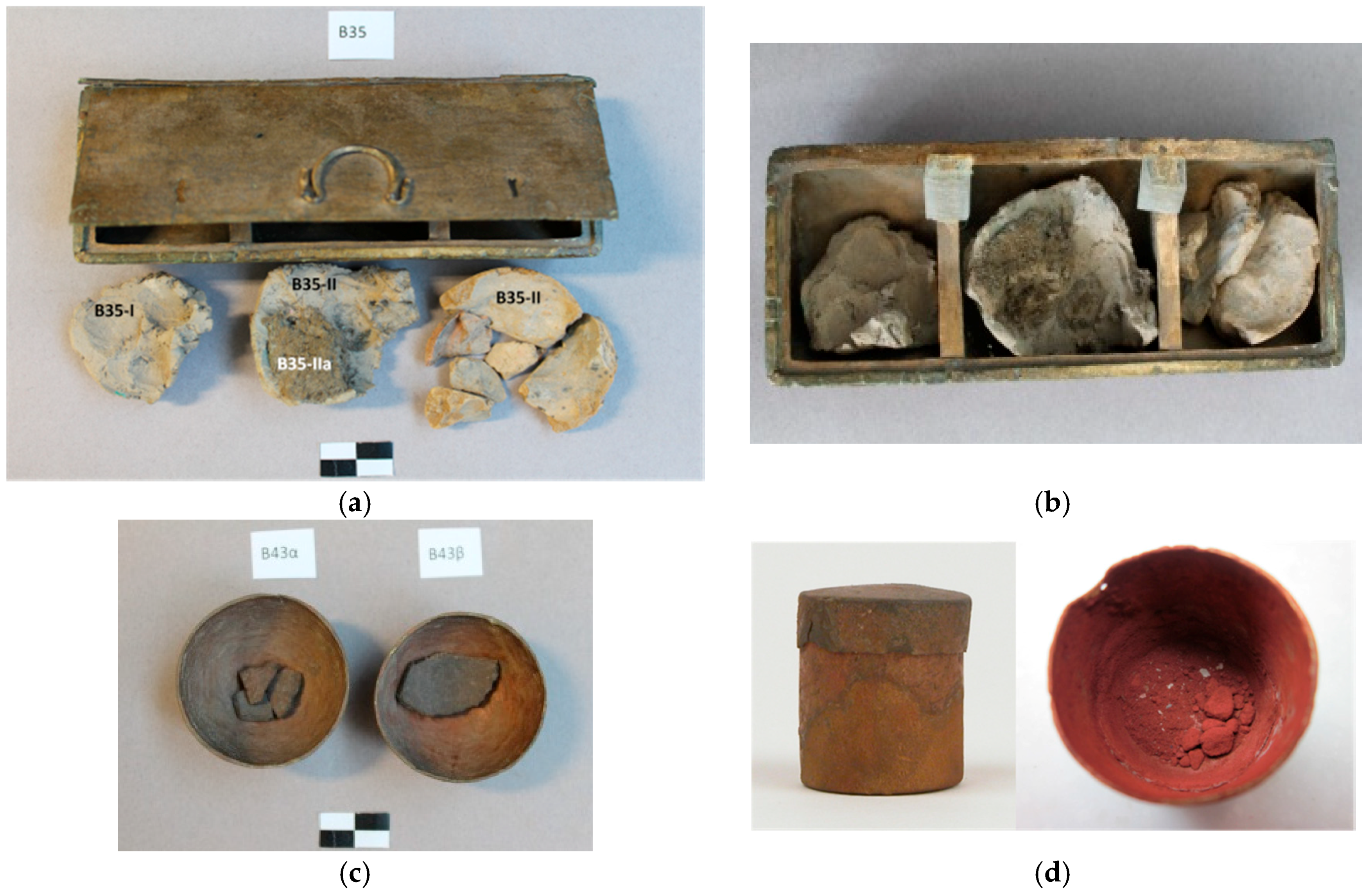
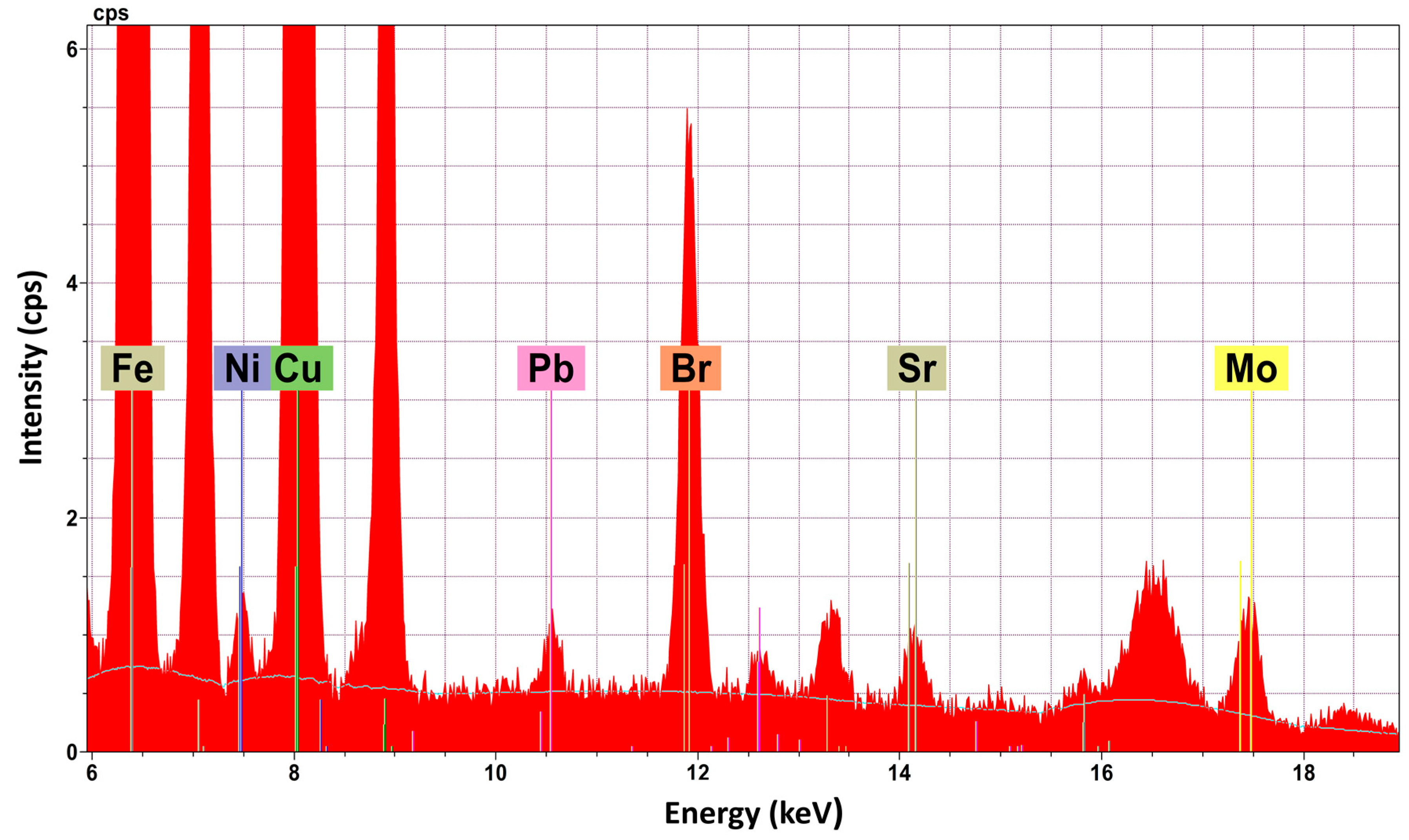
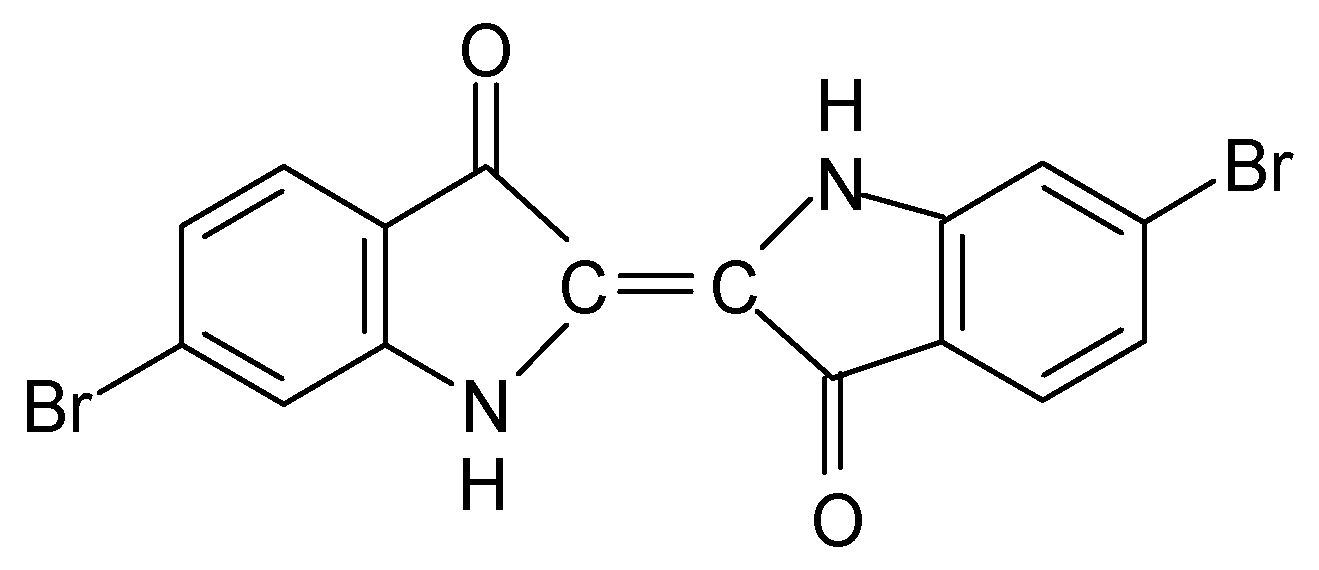
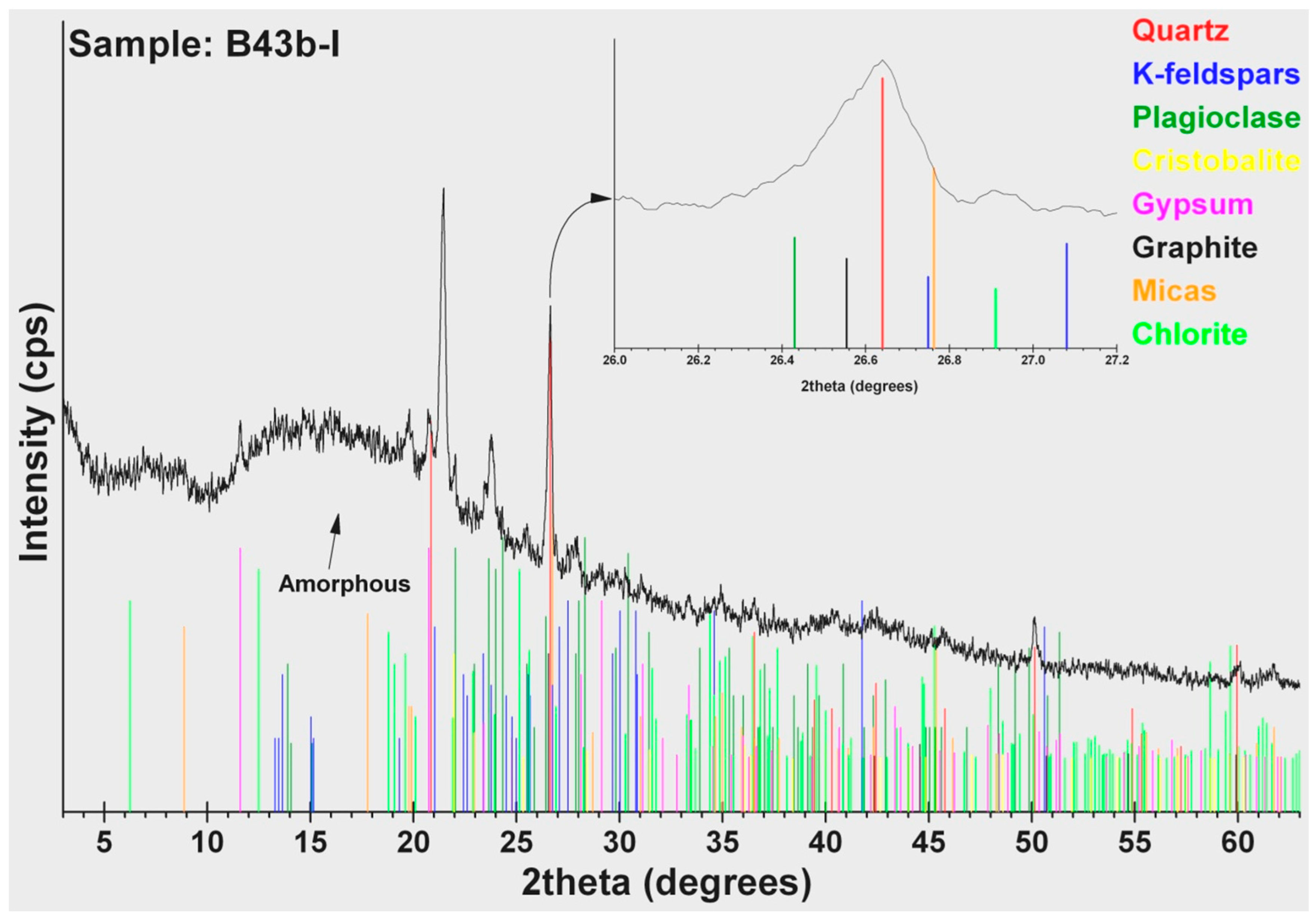
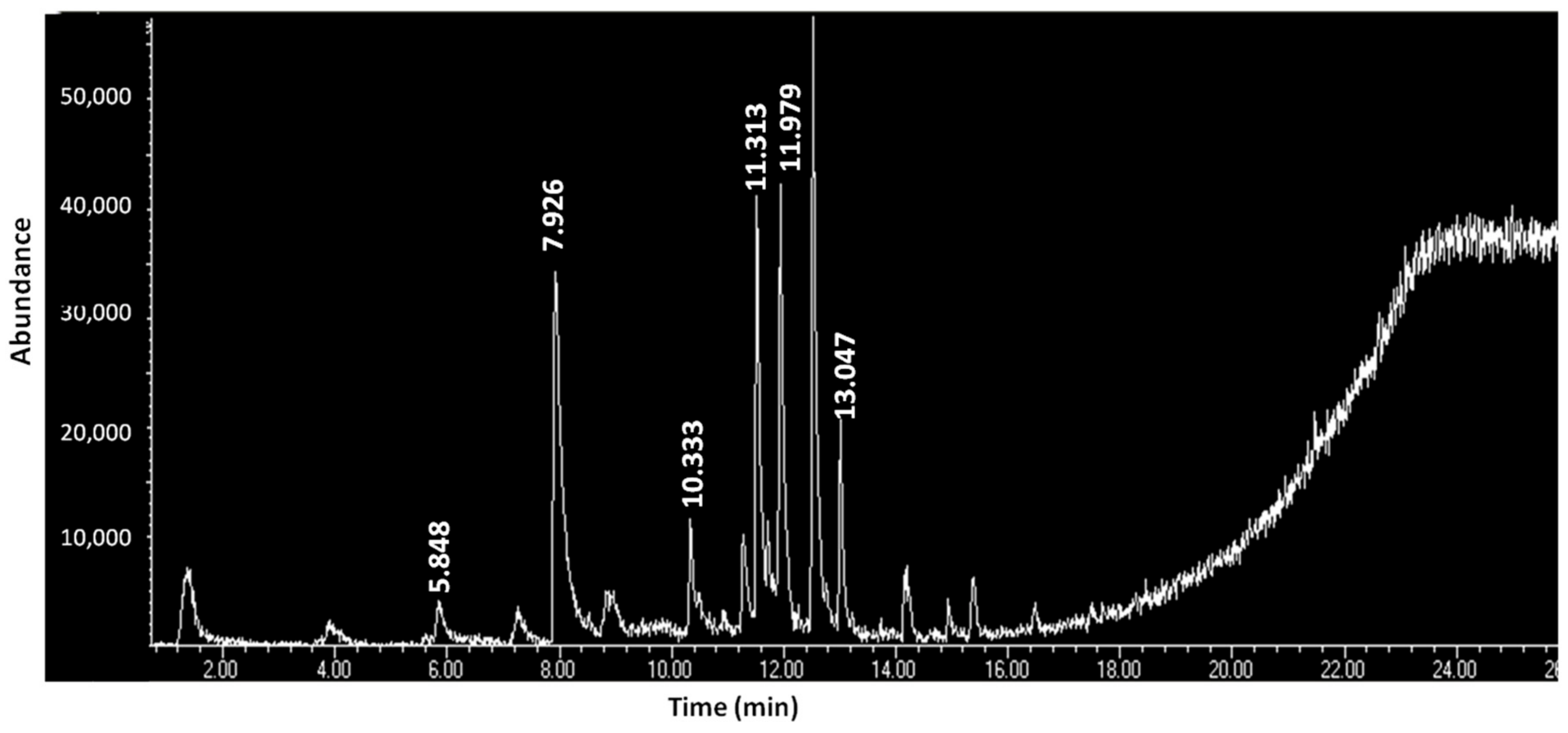
| BCR-691 | Sn | Zn | Pb | As | |
|---|---|---|---|---|---|
| Quaternary bronze (A) | Certified value ± unsertainty | 7.16 ± 0.21 | 6.02 ± 0.22 | 7.90 ± 0.7 | 0.19 ± 0.01 |
| Measured value ± std | 7.00 ± 0.3 | 6.20 ± 0.45 | 7.50 ± 0.50 | 0.20 ± 0.00 | |
| Brass (B) | Certified value ± unsertainty | 2.06 ± 0.07 | 14.80 ± 0.50 | 0.39 ± 0.04 | 0.10 ± 0.01 |
| Measured value ± std | 2.00 ± 0.10 | 14.50 ± 0.21 | 0.30 ± 0.06 | 0.10 ± 0.00 | |
| Arsenic copper (C) | Certified value ± unsertainty | 0.202 ± 0.029 | 0.05 ± 0.005 | 0.175 ± 0.014 | 4.6 ± 0.27 |
| Measured value ± std | 0.17 ± 0.06 | 0.03 ± 0.01 | 0.18 ± 0.04 | 4.5 ± 0.50 | |
| Lead bronze (D) | Certified value ± unsertainty | 10.1 ± 0.80 | 0.148 ± 0.024 | 9.2 ± 1.7 | 0.285 ± 0.022 |
| Measured value ± std | 9.60 ± 0.50 | 0.17 ± 0.02 | 9.05 ± 0.416 | 0.26 ± 0.05 | |
| Tin bronze (E) | Certified value ± unsertainty | 7 ± 0.60 | 0.157 ± 0.025 | 0.204 ± 0.018 | 0.194 ± 0.02 |
| Measured value ± std | 7.33 ± 0.50 | 0.17 ± 0.01 | 0.2 ± 0.00 | 0.2 ± 0.00 | |
| Estimated detection limits (%) | 0.02 | 0.01 | 0.03 | 0.01 | |
| Operating Conditions | Value |
|---|---|
| GC model | Agilent 6873 K gas chromatograph (Electron Ionization mode) |
| Column DB-5MS (capillary) | 30 m × 0.25 mm × 0.10 μm |
| Injector port temperature | 200 °C (SPME fiber was remained there for 6 min) |
| Carrier gas, Flow-rate | Helium, 2.0 mL/min (constant pressure at 29.8 psi) |
| Oven temperature program | 60 °C (3 min) to 270 °C, 10 °C/min ramp time |
| Transfer line temperature | 250 °C |
| MS model | Agilent 5973 quadrupole mass detector (Scan mode) |
| Total time of chromatographic analysis | 40 min |
| No | Description | Cu | Sn | Pb | Fe | As | Ni | Ca | Ti |
|---|---|---|---|---|---|---|---|---|---|
| 1 | B35-body | 87.61 ± 0.60 | 12.11 ± 0.20 | 0.19 ± 0.04 | 0.06 ± 0.02 | 0.02 ± 0.01 | nd* | 0.01 ± 0.00 | nd |
| 2 | B35-lid | 87.68 ± 0.50 | 12.07 ± 0.30 | 0.12 ± 0.02 | 0.08 ± 0.03 | 0.04 ± 0.01 | nd | 0.02 ± 0.01 | nd |
| 3 | B35-lid-handle | 85.33 ± 0.30 | 14.42 ± 0.20 | 0.15 ± 0.03 | 0.06 ± 0.02 | 0.01 ± 0.00 | nd | 0.03 ± 0.01 | nd |
| 4 | B35-lid-hinge | 93.00 ± 0.60 | 6.59 ± 0.30 | 0.23 ± 0.04 | 0.13 ± 0.05 | 0.03 ± 0.01 | nd | 0.02 ± 0.01 | nd |
| 5 | B35 body-rim | 83.44 ± 0.30 | 15.62 ± 0.50 | 0.72 ± 0.04 | 0.04 ± 0.02 | 0.01 ± 0.00 | nd | 0.02 ± 0.01 | nd |
| 6 | B35-nail-01 | 99.20 ± 0.60 | 0.06 ± 0.01 | 0.35 ± 0.03 | 0.20 ± 0.03 | nd | 0.17 ± 0.03 | 0.01 ± 0.00 | 0.01 ± 0.00 |
| 7 | B35-nail-02 | 98.95 ± 0.50 | 0.76 ± 0.20 | 0.40 ± 0.02 | 0.18 ± 0.04 | nd | 0.17 ± 0.03 | 0.02 ± 0.00 | 0.01 ± 0.00 |
| 8 | B35-nail-03 | 99.22 ± 0.50 | 0.10 ± 0.02 | 0.34 ± 0.04 | 0.15 ± 0.02 | nd | 0.16 ± 0.03 | 0.02 ± 0.01 | nd |
| 9 | B35-nail-04 | 99.09 ± 0.60 | 0.12 ± 0.40 | 0.43 ± 0.06 | 0.17 ± 0.08 | nd | 0.16 ± 0.03 | 0.01 ± 0.00 | 0.01 ± 0.00 |
| 10 | B43a-body | 99.20 ± 0.40 | 0.04 ± 0.01 | 0.45 ± 0.05 | 0.14 ± 0.05 | 0.01 ± 0.00 | 0.16 ± 0.03 | 0.01 ± 0.00 | nd |
| 11 | B43b-body | 99.12 ± 0.50 | 0.04 ± 0.01 | 0.48 ± 0.02 | 0.18 ± 0.03 | 0.01 ± 0.00 | 0.17 ± 0.03 | 0.01 ± 0.00 | nd |
| 12 | B37-lid | 86.96 ± 0.40 | 12.16 ± 0.20 | 0.66 ± 0.04 | 0.07 ± 0.02 | nd | 0.15 ± 0.05 | nd | nd |
| Description | SiO2 | TiO2 | Al2O3 | Fe2O3(t) | V2O3 | Cr2O3 | MnO | MgO | CaO | CuO | NiO | ZnO | Rb2O | SrO | PbO | K2O | Br | TOTAL |
|---|---|---|---|---|---|---|---|---|---|---|---|---|---|---|---|---|---|---|
| B35-I | 42.66 ± 2.10 | 1.42 ± 0.30 | 15.53 ± 1.20 | 10.38 ± 1.10 | 0.18 ± 0.06 | 0.09 ± 0.04 | 0.31 ± 0.10 | 2.19 ± 0.20 | 4.90 ± 0.42 | 2.30 ± 0.32 | 0.01 ± 0.00 | 0.01 ± 0.00 | 0.02 ± 0.01 | 0.04 ± 0.02 | 0.01 ± 0.00 | 3.36 ± 0.45 | nd | 83.41 |
| B35-II | 29.84 ± 1.40 | 0.82 ± 0.20 | 10.75 ± 0.40 | 5.95 ± 0.40 | 0.10 ± 0.04 | 0.04 ± 0.02 | 0.18 ± 0.02 | 0.86 ± 0.40 | 3.12 ± 0.25 | 4.12 ± 0.70 | nd | 0.01 ± 0.00 | 0.01 ± 0.00 | 0.02 ± 0.01 | 0.02 ± 0.01 | 1.84 ± 0.28 | nd | 57.70 |
| B35-IIa | 16.58 ± 1.20 | 0.43 ± 0.12 | 0.28 ± 0.30 | 4.65 ± 1.00 | 0.04 ± 0.03 | 0.15 ± 0.05 | 0.06 ± 0.03 | 0.90 ± 0.20 | 4.67 ± 0.32 | 11.85 ± 1.56 | 0.03 ± 0.01 | 0.02 ± 0.01 | 0.02 ± 0.01 | 0.01 ± 0.00 | 0.01 ± 0.00 | 1.02 ± 0.04 | 0.40 ± 0.05 | 41.14 |
| B35-III | 43.94 ± 2.15 | 1.22 ± 0.30 | 18.06 ± 1.80 | 9.92 ± 1.10 | 0.22 ± 0.04 | 0.07 ± 0.03 | 0.10 ± 0.02 | 1.84 ± 0.35 | 2.00 ± 0.24 | 2.02 ± 0.35 | 0.01 ± 0.00 | 0.01 ± 0.00 | 0.02 ± 0.01 | 0.02 ± 0.01 | 0.14 ± 0.03 | 2.92 ± 0.67 | nd | 82.53 |
| B43a-I | 6.48 ± 1.20 | 0.35 ± 0.15 | 2.19 ± 0.25 | 3.57 ± 0.70 | 0.75 ± 0.25 | 0.12 ± 0.02 | 0.03 ± 0.01 | 0.86 ± 0.25 | 3.65 ± 0.18 | 12.02 ± 1.32 | 0.04 ± 0.02 | 0.01 ± 0.00 | nd | 0.01 ± 0.00 | 0.16 ± 0.00 | 0.73 ± 0.25 | nd | 30.98 |
| B43b-I | 4.43 ± 0.80 | 0.22 ± 0.30 | 1.10 ± 0.20 | 2.42 ± 0.40 | 0.44 ± 0.10 | 0.07 ± 0.03 | 0.01 ± 0.00 | 0.63 ± 0.18 | 1.78 ± 0.16 | 3.39 ± 0.88 | 0.03 ± 0.01 | nd | nd | 0.01 ± 0.00 | 0.10 ± 0.00 | 0.41 ± 0.25 | nd | 15.03 |
| B37-I | nd | nd | nd | 11.44 ± 1.10 | nd | nd | nd | nd | 0.27 ± 0.08 | 9.71 ± 1.10 | nd | 0.02 ± 0.00 | nd | nd | nd | 0.02 ± 0.00 | nd | 21.47 |
| Sample | Quartz | Plagioclase | Mica | Chlorite | Dolomite | Amorphοus | K-Feldspar | Calcite | Amphibole | Cristobalite | Gypsum | Graphite | Hydrozincite | Hematite | Magnetite | Bassanite | Inderite | Antlerite |
|---|---|---|---|---|---|---|---|---|---|---|---|---|---|---|---|---|---|---|
| Β35-I | 39 | 28 | 14 | 8 | nd | 5 | nd | nd | 5 | nd | nd | nd | 1 | nd | nd | nd | nd | nd |
| Β35-II | 43 | 8 | 9 | 5 | nd | 18 | 7 | 7 | 3 | nd | nd | nd | nd | nd | nd | nd | nd | nd |
| B35-IIa | 42 | 9 | 8 | 7 | 3 | 31 | nd | nd | nd | nd | nd | nd | nd | nd | nd | nd | nd | nd |
| Β35-III | 44 | 13 | 6 | 4 | nd | 16 | 8 | 6 | 3 | nd | nd | nd | nd | nd | nd | nd | nd | nd |
| Β43a-I | 7 | 1 | 1 | 1 | nd | 78 | nd | nd | nd | 6 | 5 | 1 | nd | nd | nd | nd | nd | nd |
| Β43b-I | 11 | 1 | 1 | nd | nd | 65 | 2 | nd | nd | 12 | 5 | 1 | nd | nd | nd | 2 | nd | nd |
| Β37-I | nd | nd | nd | nd | nd | nd | nd | nd | nd | nd | 8 | nd | nd | 62 | 9 | 5 | 1 | 15 |
| No | RT (min) | Chemical Compound | Chemical Formula | B35-I | B35-II | B35-IIa | B35-III | B43a-I | B43b-I | B37-I |
|---|---|---|---|---|---|---|---|---|---|---|
| 1 | 1.205 | Ethanethioamide | C2H5NS | nd | nd | nd | nd | nd | nd | + |
| 2 | 1.422 | 2,4-Hexadiyne | C6H6 | nd | nd | + | nd | nd | nd | nd |
| 3 | 1.827 | 2,4,6,8-tetramethyl-1-undecene | C15H30 | nd | nd | nd | nd | nd | nd | + |
| 4 | 1.841 | Caprolactam | C6H11NO | nd | nd | nd | nd | nd | nd | + |
| 5 | 2.587 | Pentane, 2,3-dimethyl | C7H16 | nd | nd | nd | nd | nd | nd | + |
| 6 | 3.136 | Napthalene-1-isocyano | C11H7N | nd | nd | nd | nd | nd | nd | + |
| 7 | 3.151 | 1-Octanol, 2-butyl- | C12H26O | nd | nd | + | nd | nd | nd | nd |
| 8 | 3.939 | Propanoic acid, 2-methyl-,butylester | C8H16O2 | nd | nd | + | nd | nd | nd | nd |
| 9 | 5.848 | Pentanoic acid | C19H30O3 | nd | nd | + | nd | nd | nd | nd |
| 10 | 7.267 | Didodecyl phthalate | C32H54O4 | nd | nd | + | nd | nd | nd | nd |
| 11 | 7.926 | 1,3-Dioxolane-2-propanoic acid, 2-methyl-,ethylester | C9H16O4 | nd | nd | + | nd | nd | nd | nd |
| 12 | 8.855 | Hexane, 3,3-dimethyl | C8H18 | nd | nd | + | nd | nd | nd | nd |
| 13 | 10.333 | Nonadecane | C19H40 | nd | nd | + | nd | nd | nd | nd |
| 14 | 10.925 | 2,5,8,-Triphenylbenzotristriazole | C24H15N9 | nd | nd | + | nd | nd | nd | nd |
| 15 | 10.932 | 8-Benzylquinoline | C16H13N | nd | nd | + | nd | nd | nd | nd |
| 16 | 10.962 | Benzimidazo[2,1-a]isoquinoline | C15H10N2 | nd | nd | + | nd | nd | nd | nd |
| 17 | 11.105 | Butane, 1-chloro-3,3-dimethyl | C6H13Cl | nd | nd | nd | nd | + | + | + |
| 18 | 11.249 | 1,2-Benzenedicarboxylic acid, bis[2-methylpropyl] ester | C16H22O4 | nd | nd | + | nd | nd | nd | nd |
| 19 | 11.284 | Phthalic acid, 6-ethyl-3-octylisobutylester | C22H34O4 | nd | nd | + | nd | nd | nd | nd |
| 20 | 11.313 | 1,2-Benzenedicarboxylic acid, bis[2-methylpropyl] ester | C16H22O4 | nd | nd | + | nd | nd | nd | nd |
| 21 | 11.569 | 6-Undecylamine | C11H25N | nd | nd | + | nd | nd | nd | nd |
| 22 | 11.935 | 1,4-Oxathiin, 2,3-dihydro-6-methyl | C5H8OS | nd | nd | + | nd | nd | nd | nd |
| 23 | 11.979 | Formic acid, ethoxymethylene hydrazide | C4H8N2O2 | nd | nd | + | nd | nd | nd | nd |
| 24 | 12.509 | Dibutylphthalate | C16H22O4 | nd | nd | nd | nd | + | + | + |
| 25 | 12.515 | Dibutylphthalate | C16H22O4 | nd | nd | + | nd | nd | nd | nd |
| 26 | 12.520 | 1,4-Benzenedicarboxylic acid, bis[2-methylpropyl] ester | C16H22O4 | nd | nd | + | nd | nd | nd | nd |
| 27 | 12.586 | Dibutylphthalate | C16H22O4 | nd | nd | + | nd | nd | nd | nd |
| 28 | 13.007 | Sulfurous acid, butyldecylester | C14H30O3S | nd | nd | nd | nd | + | + | nd |
| 29 | 13.047 | Nonadecane, 2-methyl- | C20H42 | nd | nd | + | nd | nd | nd | nd |
| 30 | 14.166 | Morpholineethanamine | C6H14N2O | nd | nd | + | nd | nd | nd | nd |
| 31 | 14.203 | Thiophene3-(1,1-dimethylethoxy) | C8H12OS | nd | nd | + | nd | nd | nd | nd |
| 32 | 14.956 | p-Terphenyl | C18H14 | nd | nd | + | nd | nd | nd | nd |
| 33 | 15.417 | 2-Piperidinecarboxylic acid, methylester, PFP | C10H12F5NO3 | nd | nd | + | nd | nd | nd | nd |
| 34 | 16.485 | 1-(Prop-2-ynyl)-3,3-bis(trifluoromethyl)diaziridine | C6H4F6N2 | nd | nd | + | nd | nd | nd | nd |
| 35 | 24.458 | Boron, bis{μ-[(3,5-bis(1,1-dimethylethyl)-1 H-pyrazolato-N1:N2]}diethyl- | C26H50B2N4 | nd | nd | nd | + | nd | nd | nd |
| 36 | 25.072 | 10-Ethyl-3-chloro-7-(N-p-nitrobenzyldeneamino)-phenothiazine | C21H16ClN3O2S | nd | nd | nd | + | nd | nd | nd |
| 37 | 27.215 | Yohimban-16-carboxylic acid, 17-hydroxy-10-methoxy-, methylester… | C22H28N2O4 | + | nd | nd | nd | nd | nd | nd |
| 38 | 28.978 | Hexadecanoic acid, 2-hydroxy-1,3-propanediylester | C35H68O5 | + | nd | nd | nd | nd | nd | nd |
| 39 | 30.384 | 9-Octadecanoic acid (Z)-2 hydroxy-1,3-propanediylester | C39H72O5 | nd | nd | nd | + | nd | nd | nd |
| 40 | 38.123 | 9-Octadecanoic acid (Z)-2 hydroxy-3- propanediylester | C37H70O5 | + | nd | nd | nd | nd | nd | nd |
© 2018 by the authors. Licensee MDPI, Basel, Switzerland. This article is an open access article distributed under the terms and conditions of the Creative Commons Attribution (CC BY) license (http://creativecommons.org/licenses/by/4.0/).
Share and Cite
Katsifas, C.S.; Ignatiadou, D.; Zacharopoulou, A.; Kantiranis, N.; Karapanagiotis, I.; Zachariadis, G.A. Non-Destructive X-ray Spectrometric and Chromatographic Analysis of Metal Containers and Their Contents, from Ancient Macedonia. Separations 2018, 5, 32. https://doi.org/10.3390/separations5020032
Katsifas CS, Ignatiadou D, Zacharopoulou A, Kantiranis N, Karapanagiotis I, Zachariadis GA. Non-Destructive X-ray Spectrometric and Chromatographic Analysis of Metal Containers and Their Contents, from Ancient Macedonia. Separations. 2018; 5(2):32. https://doi.org/10.3390/separations5020032
Chicago/Turabian StyleKatsifas, Christos S., Despina Ignatiadou, Anastasia Zacharopoulou, Nikolaos Kantiranis, Ioannis Karapanagiotis, and George A. Zachariadis. 2018. "Non-Destructive X-ray Spectrometric and Chromatographic Analysis of Metal Containers and Their Contents, from Ancient Macedonia" Separations 5, no. 2: 32. https://doi.org/10.3390/separations5020032
APA StyleKatsifas, C. S., Ignatiadou, D., Zacharopoulou, A., Kantiranis, N., Karapanagiotis, I., & Zachariadis, G. A. (2018). Non-Destructive X-ray Spectrometric and Chromatographic Analysis of Metal Containers and Their Contents, from Ancient Macedonia. Separations, 5(2), 32. https://doi.org/10.3390/separations5020032







